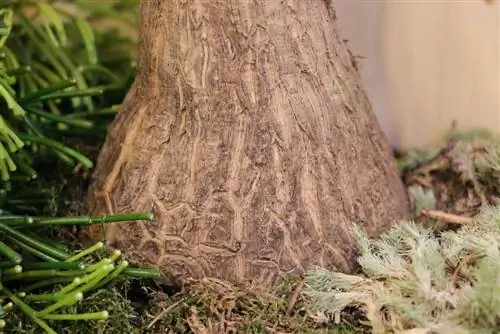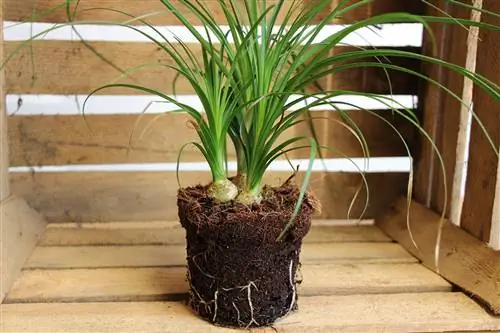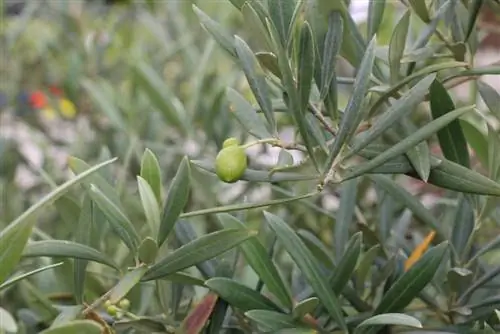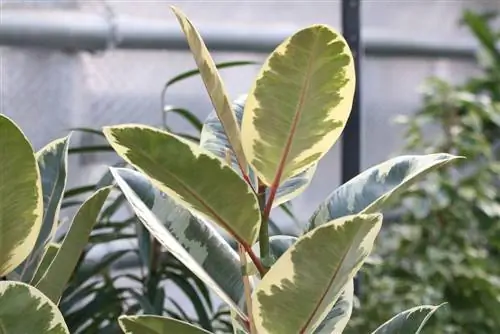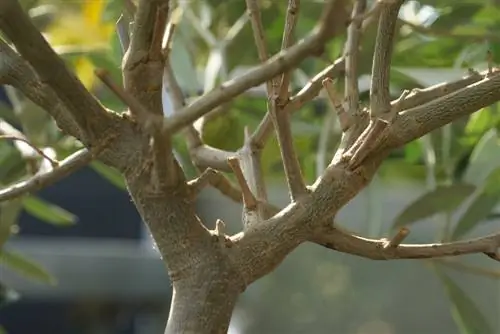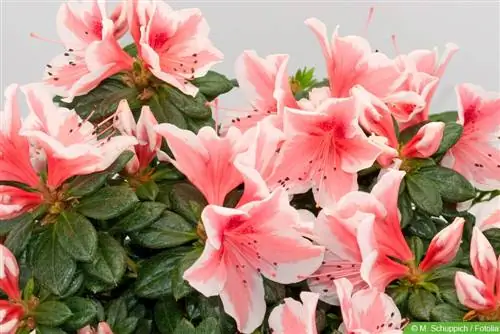- Author admin [email protected].
- Public 2023-12-17 03:39.
- Last modified 2025-06-01 06:48.
If you are thinking about purchasing a Beaucarnea recurvata, you will be able to look forward to an easy-to-care succulent that does not place high demands on the soil or fertilizer. But even the elephant's foot is not protected from all symptoms of disease, which is reflected in brown leaf tips and the loss of numerous leaves. Use the following tips to combat this problem.
Brown tips - causes
One of the most common problems with elephant feet are leaf tips, which increasingly turn brown and no longer appear he althy. Since the elephant's foot is actually a really easy-care plant, it can quickly happen that the wrong approach is taken and many gardeners have no idea how to deal with the loss of greenery. One of the main aspects of caring for an elephant foot is to directly imitate the original living conditions from which the plant comes. It comes from areas characterized by tropical, dry forests where storing water in the trunk is essential for survival. Mexico is one of the countries where Beaucarnea recurvata can be found in the natural environment and grows there together with Pitaya de Tortuga and cacti of the genus Neobuxbaumia scoparia. For this reason, it is important to provide the elephant's foot with these conditions. The following causes cause brown leaf tips:
- Pouring over
- too little water
- Waterlogging
- Age of the plant
- not enough space
- Cut
- Dust
- Pot size
Overwatering and waterlogging
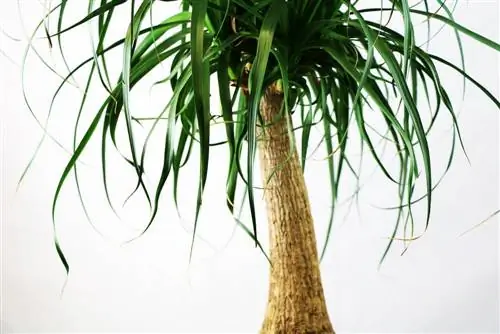
Probably the most common cause of an elephant foot whose leaves turn brown is overwatering or even waterlogging. Since the plant comes from the dry regions of Mexico, waterlogging in any form should be avoided because the tree stores water in its trunk, more precisely the caudex, which is also the inspiration of the name. The thickness of Beaucarnea recurvata is important to enable he althy growth, as it can grow to a height of nine meters. If too much water accumulates and cannot be processed, the roots will rot. Something should be done immediately to combat waterlogging, otherwise the plant will die, as it will rot from the inside and will no longer be able to regenerate. Although the tree always needs some water, especially when it is very dry in winter, overwatering can cause problems that can seriously affect the elephant's foot.
Not enough water
Just as Beaucarnea recurvata cannot tolerate too much water, it must not dry out either. Its water storage means it is protected against long-term damage, but that is no guarantee that the plant will survive to the last drop. The warmer and drier it gets, the more water the plant needs and the more it draws on the reserves in its trunk. If you forget to water the plant enough, the entire root ball can dry out and the plant can no longer be saved.
Tip:
If you're worried about overwatering but want to keep your elephant's foot from drying out, spray the leaves twice a week. This prevents them from drying out and does not overload the roots with excessive moisture.
Old elephant feet
With its stockiness and robust growth, the elephant's foot is one of the trees that can take care of itself for a long time. The same goes for the leaves, because the tree doesn't really need any pruning. The old leaves naturally turn brown over time and are replaced by fresh green leaves. This is the normal rhythm of the plant and for this reason it can happen that as the elephant's foot gets older, there will be a lot of brown leaf tips. However, a distinction must be made between the formation of new leaves and discoloration due to poor he alth. You can recognize he althy brown leaves because they change color slowly and do not appear too suddenly. You could say the leaves are changing color at a pleasant pace. If new leaves are also being formed, rest assured that it is an age-related condition.
Lack of space
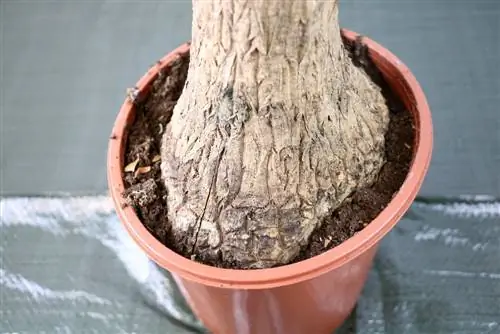
Lack of space is a common cause of brown leaf tips, because the elephant's foot needs a lot of space to be able to develop in a relaxed manner. In addition to the size of the pot, the space given to the leaves is crucial because they must not be disturbed by obstacles or walls. Hitting the leaves against walls, ceilings, stairs, railings or similar is not good for the tips of the leaves, which should neither bend nor constrict. This is because succulent plants, including aloe vera, provide their leaves, branches and trunk with a lot of moisture and can therefore withstand the dry temperatures in the heat of Mexico. But if the natural flow of moisture within the plant is disrupted, excess moisture occurs in certain areas and the tips of the leaves begin to discolor. The freer the elephant tree is, the better it is for the “Ponytail Palm”.
The flower pot
A nutrient deficiency is also a cause of brown leaf tips, but this is rather rare. The plant tolerates fertilizer in small amounts and that means the pot size is often the cause of the condition. If the pot is too small or the plant has not yet been repotted, the root ball can no longer absorb enough nutrients, which results in brown tips. Therefore, you should always choose a larger pot that the plant can still fit into as it grows.
Tip:
When you plant elephant's foot in the garden, you don't really have to pay attention to a pot size. But Beaucarnea recurvata is particularly suitable as a solitary plant, as the tree always has enough space to grow.
Cut
If you have had to cut the leaves due to previous problems with the plant, this may affect the color. Due to the cut, all elephant feet actually turn brown, but this is a shade of brown that represents a regeneration phase. Therefore, you don't have to worry about the cutting area as long as you don't cut off too much.
Dust

The elephant foot is comparatively sensitive to dust and should therefore always be wiped off. If too much dust forms, pests are attracted or the plant can no longer breathe properly and discoloration occurs. Tip: By wiping the leaves, the elephant's foot actually absorbs moisture and therefore needs to be watered less.
Elephant foot loses leaves - causes
While leaf tip discoloration is easy to fix, if the leaves are lost it may be too late or the elephant's foot needs immediate help. Leaf loss is primarily evidenced by lighter leaves that either break or fall off over time. Many of the causes mentioned above can also be found in leaf loss, but other points become visible that can severely limit the he alth of Beaucarnea recurvata:
- Not enough light
- Soil not loose enough
- Infestation by spider mites
- Humidity
The elephant's foot needs a lot of light and is best placed in a south-facing window or on a balcony that is always facing the sun. Likewise in the garden, because it doesn't tolerate shade at all. If the soil is too dense, the roots can suffer because Beaucarnea recurvata prefers to stay in loose substrate so as not to absorb too much water and to receive enough oxygen. If the air humidity is too high, this also affects the he alth of the leaves, as they may attract spider mites, which like to stay in human living spaces. The infestation by the mites is noticeable in numerous spider threads and webs on the leaves and the leaves almost break off from the trunk. Tip: Elephant's foot loves dry apartments, even in winter. But the temperature should never fall below 8°C, otherwise the leaves can freeze.
Tips against brown leaf tips and leaf loss
If your elephant foot exhibits any of the above symptoms, you should take immediate action. Although the plant is very easy to care for and forgiving of mistakes, over time this can result in a sudden loss of the “Ponytail Palm”. With the following tips you are well prepared.

- If you have watered the elephant's foot, you should refrain from watering it for a while. The plant can withstand dry periods of up to four weeks, especially in autumn and winter, and therefore only needs regular watering when the soil is really bone dry.
- If waterlogging occurs, the elephant's foot must be repotted immediately, as the entire root ball can rot within a few days. To do this, take the plant out of the pot and remove the rotten areas with a sharp knife and then place the elephant foot in fresh, permeable soil in which it can dry.
- Don't forget to water the plant regularly. Here it helps to orientate yourself on the soil in the pot and the hotter and sunnier it is outside, the more often the elephant's foot needs to be watered, similar to a cactus or aloe vera.
- Brown leaf tips can be prevented with a location that is either elevated or far enough away from walls and ceilings. Be careful not to place the elephant foot in close proximity to the heater. The heating air is not necessarily bad for Beaucarnea recurvata, but heat can have a negative effect on the fresh leaves, which can dry out and fall off.
- Wipe the elephant's foot leaves twice a week with a damp cloth to remove dust from the plant. This allows the elephant's foot to breathe freely.
- Pay attention to the pot size and be sure to adapt it to the size of the root ball. Here it is advisable to leave enough space to the edge to support the rapid growth of the strong plant.
- The humidity is crucial for the elephant's foot, as the asparagus plant comes from the tropical regions of the world. If the humidity is too low, the tips of the leaves and the entire leaf can suffer and a possible infestation by spider mites can set in, as they do not like high humidity. Ideal humidity is between 50 and 75 percent.
- Choose a sunny location for the elephant's foot. Just enough light works wonders for this tree and if you live in a region that has very little light in winter, use a daylight lamp to provide Beaucarnea recurvata with enough light.
- If you want to cut off brown leaf tips, which is completely ok to limit the damage so far, you should proceed very carefully. To do this, choose sharp and clean scissors and cut off as little as possible. Never use too much, otherwise you could damage he althy leaves, which will then fall off. Never cut into he althy greens, even if they are too long for your taste, because elephant feet tolerate pruning extremely poorly and is not recommended.
- If you want your elephant's foot to be more robust, you should not use fertilizer in winter and hardly water it. This way the leaves stay he althy and grow out even stronger and he althier in the new year.

